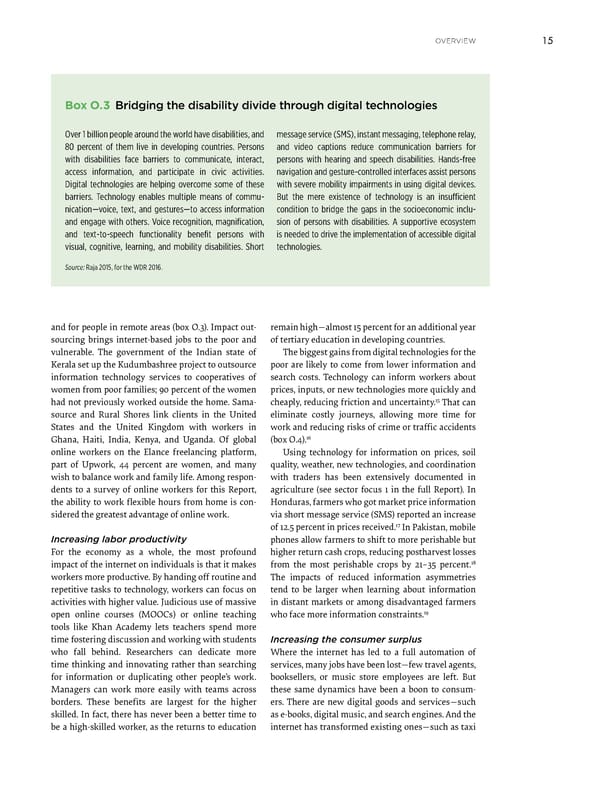overview 15 Box O.3 Bridging the disability divide through digital technologies Over 1 billion people around the world have disabilities, and message service (SMS), instant messaging, telephone relay, 80 percent of them live in developing countries. Persons and video captions reduce communication barriers for with disabilities face barriers to communicate, interact, persons with hearing and speech disabilities. Hands-free access information, and participate in civic activities. navigation and gesture-controlled interfaces assist persons Digital technologies are helping overcome some of these with severe mobility impairments in using digital devices. barriers. Technology enables multiple means of commu- But the mere existence of technology is an insufficient nication—voice, text, and gestures—to access information condition to bridge the gaps in the socioeconomic inclu- and engage with others. Voice recognition, magnification, sion of persons with disabilities. A supportive ecosystem and text-to-speech functionality benefit persons with is needed to drive the implementation of accessible digital visual, cognitive, learning, and mobility disabilities. Short technologies. Source: Raja 2015, for the WDR 2016. and for people in remote areas (box O.3). Impact out- remain high—almost 15 percent for an additional year sourcing brings internet-based jobs to the poor and of tertiary education in developing countries. vulnerable. The government of the Indian state of The biggest gains from digital technologies for the Kerala set up the Kudumbashree project to outsource poor are likely to come from lower information and information technology services to cooperatives of search costs. Technology can inform workers about women from poor families; 90 percent of the women prices, inputs, or new technologies more quickly and had not previously worked outside the home. Sama- cheaply, reducing friction and uncertainty.15 That can source and Rural Shores link clients in the United eliminate costly journeys, allowing more time for States and the United Kingdom with workers in work and reducing risks of crime or traffic accidents Ghana, Haiti, India, Kenya, and Uganda. Of global 16 (box O.4). online workers on the Elance freelancing platform, Using technology for information on prices, soil part of Upwork, 44 percent are women, and many quality, weather, new technologies, and coordination wish to balance work and family life. Among respon- with traders has been extensively documented in dents to a survey of online workers for this Report, agriculture (see sector focus 1 in the full Report). In the ability to work flexible hours from home is con- Honduras, farmers who got market price information sidered the greatest advantage of online work. via short message service (SMS) reported an increase of 12.5 percent in prices received.17 In Pakistan, mobile Increasing labor productivity phones allow farmers to shift to more perishable but For the economy as a whole, the most profound higher return cash crops, reducing postharvest losses impact of the internet on individuals is that it makes from the most perishable crops by 21–35 percent.18 workers more productive. By handing off routine and The impacts of reduced information asymmetries repetitive tasks to technology, workers can focus on tend to be larger when learning about information activities with higher value. Judicious use of massive in distant markets or among disadvantaged farmers open online courses (MOOCs) or online teaching who face more information constraints.19 tools like Khan Academy lets teachers spend more time fostering discussion and working with students Increasing the consumer surplus who fall behind. Researchers can dedicate more Where the internet has led to a full automation of time thinking and innovating rather than searching services, many jobs have been lost—few travel agents, for information or duplicating other people’s work. booksellers, or music store employees are left. But Managers can work more easily with teams across these same dynamics have been a boon to consum- borders. These benefits are largest for the higher ers. There are new digital goods and services—such skilled. In fact, there has never been a better time to as e-books, digital music, and search engines. And the be a high-skilled worker, as the returns to education internet has transformed existing ones—such as taxi
 World Development Report 2016 Page 27 Page 29
World Development Report 2016 Page 27 Page 29